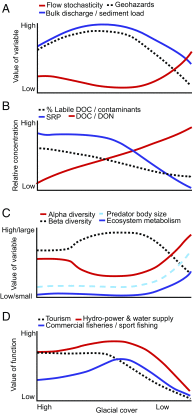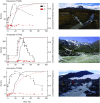Glacier shrinkage driving global changes in downstream systems
- PMID: 28874558
- PMCID: PMC5603989
- DOI: 10.1073/pnas.1619807114
Glacier shrinkage driving global changes in downstream systems
Abstract
Glaciers cover ∼10% of the Earth's land surface, but they are shrinking rapidly across most parts of the world, leading to cascading impacts on downstream systems. Glaciers impart unique footprints on river flow at times when other water sources are low. Changes in river hydrology and morphology caused by climate-induced glacier loss are projected to be the greatest of any hydrological system, with major implications for riverine and near-shore marine environments. Here, we synthesize current evidence of how glacier shrinkage will alter hydrological regimes, sediment transport, and biogeochemical and contaminant fluxes from rivers to oceans. This will profoundly influence the natural environment, including many facets of biodiversity, and the ecosystem services that glacier-fed rivers provide to humans, particularly provision of water for agriculture, hydropower, and consumption. We conclude that human society must plan adaptation and mitigation measures for the full breadth of impacts in all affected regions caused by glacier shrinkage.
Keywords: biodiversity; biogeochemistry; ecosystem services; glacier; runoff.
Conflict of interest statement
The authors declare no conflict of interest.
Figures





References
-
- Kaser G, Gogley JG, Dyurgerov MB, Meier MF, Ohmura A. Mass balance of glaciers and ice caps: Consensus estimates for 1961-2004. Geophys Res Lett. 2006;33:L19501.
-
- Pfeffer WT, et al. The Randolph Glacier Inventory: A globally complete inventory of glaciers. J Glaciol. 2014;60:537–552.
-
- Gardner AS, et al. A reconciled estimate of glacier contributions to sea level rise: 2003 To 2009. Science. 2013;340:852–857. - PubMed
-
- Bliss A, Hock R, Radić V. Global response of glacier runoff to twenty-first century climate change. J Geophys Res Earth Surf. 2014;119:717–730.
-
- Jacob T, Wahr J, Pfeffer WT, Swenson S. Recent contributions of glaciers and ice caps to sea-level rise. Nature. 2012;482:514–518. - PubMed
Publication types
MeSH terms
LinkOut - more resources
Full Text Sources
Other Literature Sources

